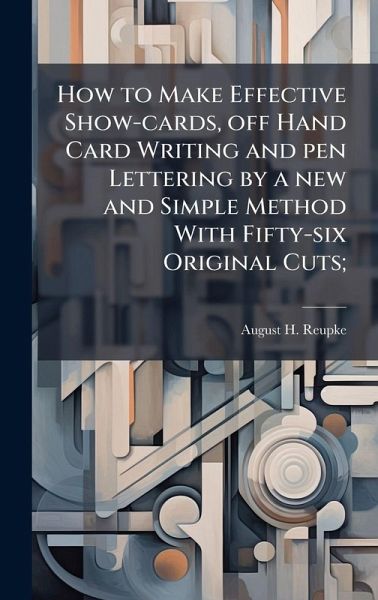
How to Make Effective Show-cards, off Hand Card Writing and pen Lettering by a new and Simple Method With Fifty-six Original Cuts;
Versandkostenfrei!
Versandfertig in über 4 Wochen
29,99 €
inkl. MwSt.
Weitere Ausgaben:

PAYBACK Punkte
15 °P sammeln!
"How to Make Effective Show-cards" (1898) is a practical guide to creating eye-catching signs and lettering for advertising and display. August H. Reupke presents a straightforward method for off-hand card writing and pen lettering, making it accessible to beginners and useful for experienced sign painters. The book features fifty-six original cuts and illustrations, offering visual examples of effective design and lettering techniques. This manual provides instruction on creating impactful visuals for commercial purposes, making it a valuable resource for anyone interested in the art of sign ...
"How to Make Effective Show-cards" (1898) is a practical guide to creating eye-catching signs and lettering for advertising and display. August H. Reupke presents a straightforward method for off-hand card writing and pen lettering, making it accessible to beginners and useful for experienced sign painters. The book features fifty-six original cuts and illustrations, offering visual examples of effective design and lettering techniques. This manual provides instruction on creating impactful visuals for commercial purposes, making it a valuable resource for anyone interested in the art of sign making and hand-lettered advertising. Its historical context offers insights into the advertising practices of the late 19th century, appealing to graphic design enthusiasts and historians alike. Discover the techniques used to capture attention and drive sales in a bygone era with this detailed and instructive guide. This work has been selected by scholars as being culturally important, and is part of the knowledge base of civilization as we know it. This work was reproduced from the original artifact, and remains as true to the original work as possible. Therefore, you will see the original copyright references, library stamps (as most of these works have been housed in our most important libraries around the world), and other notations in the work. This work is in the public domain in the United States of America, and possibly other nations. Within the United States, you may freely copy and distribute this work, as no entity (individual or corporate) has a copyright on the body of the work. As a reproduction of a historical artifact, this work may contain missing or blurred pages, poor pictures, errant marks, etc. Scholars believe, and we concur, that this work is important enough to be preserved, reproduced, and made generally available to the public. We appreciate your support of the preservation process, and thank you for being an important part of keeping this knowledge alive and relevant.


